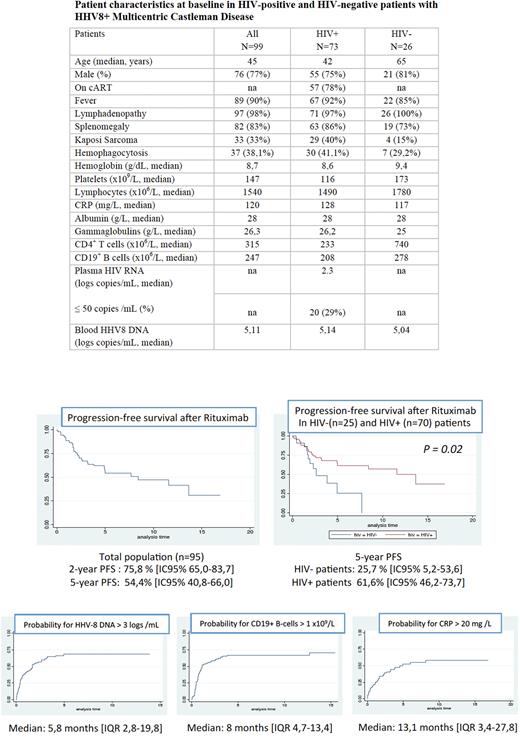Abstract
KSHV/HHV-8 associated multicentric Castleman disease (HHV-8 MCD) is a rare lymphoproliferative disorder associating lymphadenopathy, splenomegaly, fever and inflammatory symptoms with high serum CRP, hypergammaglobulinemia and high plasma HHV-8 DNA viral load. HHV-8 MCD mainly affects HIV infected patients but can also be observed in HIV negative patients born in countries with high HHV-8 prevalence.
We retrospectively analysed a cohort of 99 patients (73 HIV+ and 26 HIV-) with HHV-8 MCD treated with rituximab (off-label). The baseline characteristics were similar in HIV- and HIV+ patients although HIV- patients were older at MCD diagnosis (median, 65 vs 42 years) and presented less frequently with previous Kaposi sarcoma lesions (15% vs 40%).
Out of these 99 patients, 95 patients (25 HIV- and 70 HIV+) achieved CR after a rituximab based therapy. After a median follow-up of 51 months (743 visits), 36 patients were considered as in treatment failure because of MCD relapse, KS progression, lymphoma or death. The 5-year progression-free survival (PFS) was 54,4 % [IC95% 40,8-66,0]. Relapse or progression of HHV-8 disease occured in 12 /25 (48%) HIV- patients and in 24 /75 (32%) HIV+ patients. The 5-year PFS was lower in HIV- patients than in HIV+ patients : 25,7 % [IC95% 5,2-53,6] and 61,6% [IC95% 46,2-73,7], respectively (p= 0.02 ).
We have retrospectively analysed the kinetics of blood HHV-8 DNA, CD19+ B-cells and serum CRP after a first rituximab induced CR.
The median times for a rise of plasma HHV-8 DNA above 3 logs/mL (n=57), CD19+ B-cells above 1/mm3 (n=59) and serum CRP above 20 mg/L (n=42) were 5,8 months [IQR 2,8-19,8], 8 months [IQR 4,7-13,4] and 13,1 months [IQR 3,4-27,8], respectively. The median time for treatment failure after such events were 4,5 months [IQR 0-16,4] for HHV8-DNA, 13,9 months [IQR 2,7-22,5] for CD19+ B-cells and 2 months [IQR 0-6,9] for CRP.
These data show that in most patients, B cells became detectable again and that plasma HHV-8 DNA rose above 3 logs/mL during the first year post-rituximab and that these events could be followed by a rise in serum CRP preceding treatment failure. We suggest that these covariates should be monitored every 4-6 months although the decision of reintroducing specific therapy should still rely on the occurrence of clinical symptoms.
The lower rate of relapse observed in the HIV+ population despite a longer follow-up period, may be due to a younger age and to the possible immune reconstitution upon antiretroviral therapy in this population.
Disclosures
Oksenhendler:CSL Behring: Consultancy; EusaPharma: Consultancy. Galicier:EusaPharma: Consultancy, Honoraria, Other: Presentations, manuscript writing, educational events, Speakers Bureau; Lilly: Honoraria, Other: Presentations, manuscript writing, educational events, Speakers Bureau; Sanofi: Honoraria, Other: Presentations, manuscript writing, educational events, Speakers Bureau; Amgen: Honoraria, Other: Presentations, manuscript writing, educational events, Speakers Bureau; Novartis: Other: Support for meetings and/or travel; Janssen: Other: Support for meetings and/or travel; Cillag: Other: Support for meetings and/or travel.
OffLabel Disclosure:
Rituximab as a treatment for KSHV/HHV-8 Multicentric Castleman Disease
Author notes
Asterisk with author names denotes non-ASH members.


This feature is available to Subscribers Only
Sign In or Create an Account Close Modal